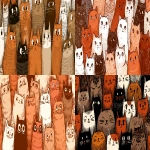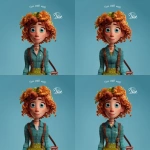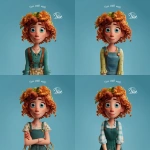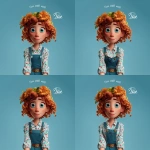Explore the Best AI Image Gallery

Cloud Computing: Shaping the Future of Creativity and Innovation
Cloud computing has emerged as a cornerstone of modern technology, reshaping not just how businesses operate but also revolutionizing creative industries. By providing powerful, scalable resources on-demand, the cloud enables artists, designers, and content creators to push the boundaries of their work. In this blog post, we will explore the advancements in cloud computing, its impact on the creative sector, potential uses, ethical considerations, and future trends.
The Evolution of Cloud Technology
Initially viewed as a mere storage solution, cloud computing has evolved into a comprehensive framework that includes a range of services, such as computing power, network provision, and application hosting. Major players in the field, including Amazon Web Services (AWS), Google Cloud Platform, and Microsoft Azure, have continuously improved their offerings, resulting in capabilities that previously seemed unattainable. Today, cloud technology can seamlessly integrate innovative tools, such as artificial intelligence (AI) and machine learning, offering unique opportunities for collaboration and creativity.
Impact on the Creative Industry
Cloud computing's impact on creative industries is multifaceted, offering new platforms for collaboration, enhanced capacities for design, and greater accessibility for creators worldwide:
- Collaboration Across Geographies: Cloud-based tools such as Google Workspace, Adobe Creative Cloud, and Slack enable creatives to work together regardless of their physical location. This has fostered more diverse teams and broadened the creative process.
- Scalability and Flexibility: The cloud allows creatives to scale their resources according to their specific project requirements. For instance, a graphic designer can leverage cloud computing to access high-performance computing power for rendering complex designs during peak times.
- Cost Efficiency: Startups and independent creators, often constrained by budgets, can access affordable cloud services, eliminating the need for significant infrastructure investment. This has democratized access to high-quality tools and resources.
Potential Uses in Creative Projects
As cloud technology continues to evolve, its applications within the creative realm expand. Here are some notable uses:
- Design and Prototyping: Designers can utilize cloud-based software for 3D modeling, prototyping, and testing. Platforms such as Autodesk Fusion 360 enable teamwork on prototypes, allowing real-time feedback and iteration.
- Video Production: In a world dominated by video content, cloud services allow for collaborative editing and storage. Tools like Frame.io enable teams to review and edit video content in real-time, streamlining the traditional film editing process.
- Music Production: Musicians can utilize cloud services for recording, mixing, and collaborating with artists from across the globe. Services like Splice provide a platform for cloud-based music collaboration enabling samples and projects to be shared easily.
Ethical Considerations
As with any technological advancement, ethical considerations come into play with cloud computing in creative fields:
- Data Privacy: As creators increasingly rely on cloud services to store sensitive project materials, data privacy becomes paramount. Companies must prioritize secure data management to protect the intellectual property of their users.
- AI and Creativity: The integration of AI in creative processes raises questions about authorship and originality. Can AI-generated works be truly considered art, or are they merely reflections of human input? This debate continues to evolve as technology advances.
- Equitable Access: While cloud computing has democratized access to resources for many, disparities in access still exist, particularly in underdeveloped regions. Ensuring equitable access to technology will be vital for fostering innovation globally.
Future Trends
The future of cloud computing in creativity is exciting and holds numerous possibilities:
- Increased Integration with AI: As AI technology continues to improve, its integration with cloud computing will likely lead to sophisticated tools that can assist in creative design, automation, and personalization of user experiences.
- Edge Computing: As latency becomes a critical factor in creative applications, edge computing will allow data processing to occur closer to the source, enhancing speed and efficiency.
- Collaboration Platforms: Future cloud platforms may evolve even more, incorporating VR and AR technologies to create immersive collaboration environments for creative teams.
In conclusion, cloud computing stands at the forefront of innovation in the creative industries, reshaping how creators design, collaborate, and share their work. While we navigate the ethical considerations and challenges that arise, the future promises a realm of possibilities where creativity knows no bounds. Embracing and leveraging these advancements will undoubtedly promote greater expression and innovation in the artistic world.









](https://images.ai-img.art/thumbnails/150/e07ad2e7379a835127482b0fd3176192c001c90e68a85b4315cf482b6a3f5ea5.webp)








](https://images.ai-img.art/thumbnails/150/d08f607caf4a5c380defef68b778febb8911e8e51e51927b09ed67880bd3084b.webp)
](https://images.ai-img.art/thumbnails/150/1871c145bfe0276c6e1bacf6ec0da6d2dae71370bf71674589af29a201acdd5f.webp)
](https://images.ai-img.art/thumbnails/150/5487dcbcab0cd5702a67cc6819342ef56c05d0fc7730bfb7718ee291f10c3da3.webp)


![**ultra detailed 8k cinematic black and white beauty portrait of a young woman from chest up, vertical frame, face, hands and hair filling the composition, smooth neutral grey studio background with soft dark vignette on the edges, center of the frame is her eye, lips and finger in a "shh" gesture oval symmetrical face with soft but well defined features, ultra smooth flawless skin, no pores, no wrinkles, perfect beauty retouch, straight elegant nose with soft highlight along the bridge and gentle shadow under the tip full sensuous lips with a sharp cupid’s bow, slightly parted, a thin bright glossy highlight strip on the lower lip emphasizing volume, subtle light reflection on the lip gloss one eye visible through a gap between fingers, other eye mostly hidden by the upper hand, long thick eyelashes like fake lashes, small bright catchlight in the pupil, upper eyelid with smoky eye makeup, darker tone along lash line fading smoothly towards the brow, dark thick well shaped eyebrows, gently arched, not overdramatic dark wavy hair, big glossy waves falling down, one clear S-shaped wave on the right side of the frame, soft highlights along the strands to show texture, hair swept away from the cheeks so the face is not covered both hands in thin semi-transparent black gloves up to the forearm, upper hand placed horizontally across the upper face, back of the hand towards camera, fingers slightly spread so that one finger is above the brows and another lower finger creates a narrow gap that reveals the eye, fingertips long and tapered, sharp stiletto-like nails visible under the sheer fabric, subtle darker seams along the fingers and glove edges lower hand bent so that the index finger is vertical and gently touching the center of the lips in a classic "shhh" pose, [...]** - Image #2 <@1264899319799222315>](https://images.ai-img.art/thumbnails/150/d87499f6bdc5a4a822aea4674654f70073b052542a1aaa1d08461a13ca2e07f9.webp)








](https://images.ai-img.art/thumbnails/150/f3411154f4c743a26f102ecfc985f3f6214e93b285748fac66c88f3b52f85b26.webp)

![**ultra detailed 8k cinematic black and white beauty portrait of a young woman from chest up, vertical frame, face, hands and hair filling the composition, smooth neutral grey studio background with soft dark vignette on the edges, center of the frame is her eye, lips and finger in a "shh" gesture oval symmetrical face with soft but well defined features, ultra smooth flawless skin, no pores, no wrinkles, perfect beauty retouch, straight elegant nose with soft highlight along the bridge and gentle shadow under the tip full sensuous lips with a sharp cupid’s bow, slightly parted, a thin bright glossy highlight strip on the lower lip emphasizing volume, subtle light reflection on the lip gloss one eye visible through a gap between fingers, other eye mostly hidden by the upper hand, long thick eyelashes like fake lashes, small bright catchlight in the pupil, upper eyelid with smoky eye makeup, darker tone along lash line fading smoothly towards the brow, dark thick well shaped eyebrows, gently arched, not overdramatic dark wavy hair, big glossy waves falling down, one clear S-shaped wave on the right side of the frame, soft highlights along the strands to show texture, hair swept away from the cheeks so the face is not covered both hands in thin semi-transparent black gloves up to the forearm, upper hand placed horizontally across the upper face, back of the hand towards camera, fingers slightly spread so that one finger is above the brows and another lower finger creates a narrow gap that reveals the eye, fingertips long and tapered, sharp stiletto-like nails visible under the sheer fabric, subtle darker seams along the fingers and glove edges lower hand bent so that the index finger is vertical and gently touching the center of the lips in a classic "shhh" pose, [...]** - Image #3 <@1264899319799222315>](https://images.ai-img.art/thumbnails/150/4c03a422708b372b43caaee1e2929933c40f0a13dc069beeeb228a60b126223b.webp)

![**ultra detailed 8k cinematic black and white beauty portrait of a young woman from chest up, vertical frame, face, hands and hair filling the composition, smooth neutral grey studio background with soft dark vignette on the edges, center of the frame is her eye, lips and finger in a "shh" gesture oval symmetrical face with soft but well defined features, ultra smooth flawless skin, no pores, no wrinkles, perfect beauty retouch, straight elegant nose with soft highlight along the bridge and gentle shadow under the tip full sensuous lips with a sharp cupid’s bow, slightly parted, a thin bright glossy highlight strip on the lower lip emphasizing volume, subtle light reflection on the lip gloss one eye visible through a gap between fingers, other eye mostly hidden by the upper hand, long thick eyelashes like fake lashes, small bright catchlight in the pupil, upper eyelid with smoky eye makeup, darker tone along lash line fading smoothly towards the brow, dark thick well shaped eyebrows, gently arched, not overdramatic dark wavy hair, big glossy waves falling down, one clear S-shaped wave on the right side of the frame, soft highlights along the strands to show texture, hair swept away from the cheeks so the face is not covered both hands in thin semi-transparent black gloves up to the forearm, upper hand placed horizontally across the upper face, back of the hand towards camera, fingers slightly spread so that one finger is above the brows and another lower finger creates a narrow gap that reveals the eye, fingertips long and tapered, sharp stiletto-like nails visible under the sheer fabric, subtle darker seams along the fingers and glove edges lower hand bent so that the index finger is vertical and gently touching the center of the lips in a classic "shhh" pose, [...]** - Image #4 <@1264899319799222315>](https://images.ai-img.art/thumbnails/150/8507c113aa12343ebd50af4ab9c637a6cf1acf21c55772271eb6a66bb04fa39c.webp)

](https://images.ai-img.art/thumbnails/150/4f3d83c4b1d979b5be00f4ea80d67b71c0335bc1163e692d738e553ac37709e5.webp)
![**ultra detailed 8k cinematic black and white beauty portrait of a young woman from chest up, vertical frame, face, hands and hair filling the composition, smooth neutral grey studio background with soft dark vignette on the edges, center of the frame is her eye, lips and finger in a "shh" gesture oval symmetrical face with soft but well defined features, ultra smooth flawless skin, no pores, no wrinkles, perfect beauty retouch, straight elegant nose with soft highlight along the bridge and gentle shadow under the tip full sensuous lips with a sharp cupid’s bow, slightly parted, a thin bright glossy highlight strip on the lower lip emphasizing volume, subtle light reflection on the lip gloss one eye visible through a gap between fingers, other eye mostly hidden by the upper hand, long thick eyelashes like fake lashes, small bright catchlight in the pupil, upper eyelid with smoky eye makeup, darker tone along lash line fading smoothly towards the brow, dark thick well shaped eyebrows, gently arched, not overdramatic dark wavy hair, big glossy waves falling down, one clear S-shaped wave on the right side of the frame, soft highlights along the strands to show texture, hair swept away from the cheeks so the face is not covered both hands in thin semi-transparent black gloves up to the forearm, upper hand placed horizontally across the upper face, back of the hand towards camera, fingers slightly spread so that one finger is above the brows and another lower finger creates a narrow gap that reveals the eye, fingertips long and tapered, sharp stiletto-like nails visible under the sheer fabric, subtle darker seams along the fingers and glove edges lower hand bent so that the index finger is vertical and gently touching the center of the lips in a classic "shhh" pose, [...]** - Image #1 <@1264899319799222315>](https://images.ai-img.art/thumbnails/150/ff5a24c7c060f5350508823c406c28c9596aea4e37eefb60abc0f37504a37383.webp)

](https://images.ai-img.art/thumbnails/150/7c4350a99935771fe343a7ae65c780cf4cd6b861e69cdc32bd58a3a92fb2476f.webp)







